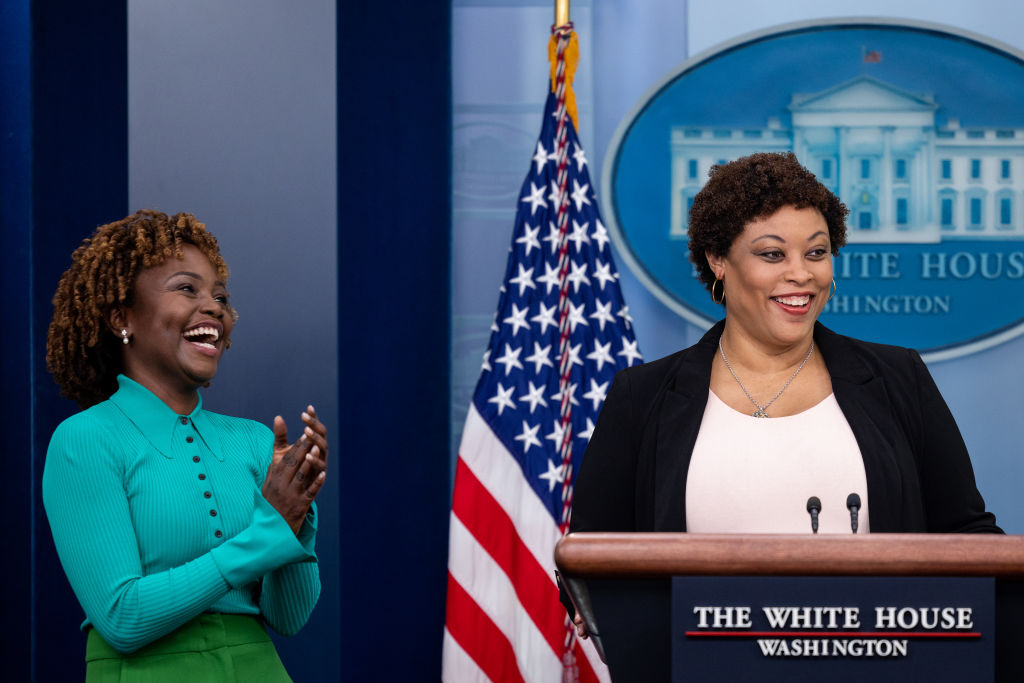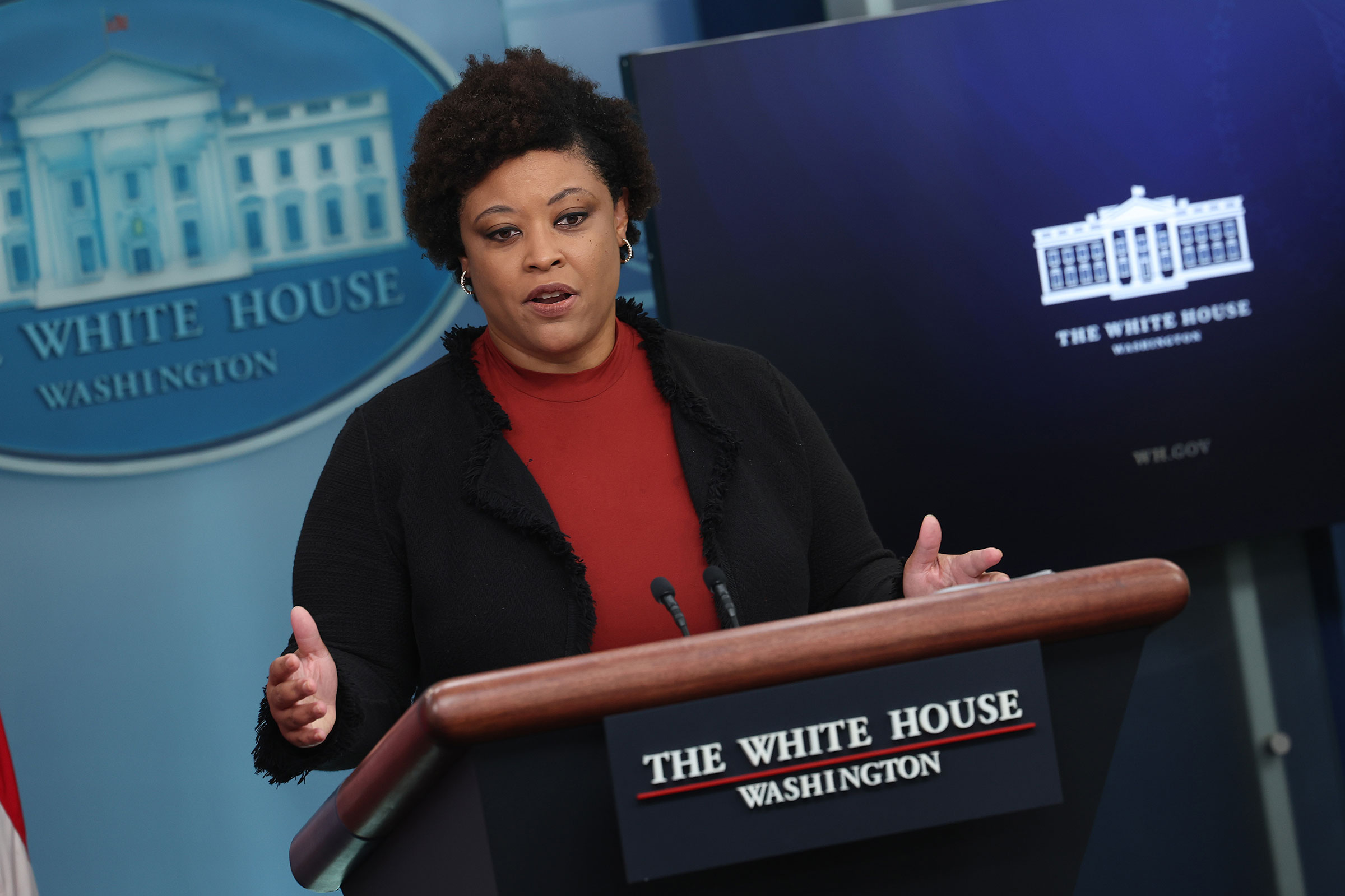
When President Biden met with top congressional leaders in the Oval Office on Tuesday, Shalanda Young was there picking up signs of optimism.
Young runs Biden’s Office of Management and Budget (OMB) and is a key player in working out spending deals with Congress. So far, Biden has avoided government shutdowns during his presidency, a feat that some credit in no small part to Young, his senior budget official who's known inside Congress and the White House as a Republican whisperer.
But with a Friday deadline looming and a deal still out of reach, many in Washington are bracing for the administration's lucky streak to run out. Late last week, Young instructed agency heads to check and update plans for a stop in funding in case Congress fails to act before staggered deadlines that begin Friday.
Speaking after the meeting Tuesday, Young was more hopeful.
"It felt like everyone was just very optimistic about getting there," she says. "Now, I worry about the clock."
Young came to her current job as director of OMB after more than 15 years working on the House Appropriations Committee, where she earned a reputation as an honest broker in nail-biting negotiations, as well as for a charismatic and informal approach that’s made some staunch conservatives her biggest fans.
“Even for a Democrat, she's got this fantastic understanding of how House Republicans think and operate,” says Rep. Patrick McHenry, a North Carolina Republican who worked closely with Young in June to come to the current spending deal that avoided a default on the nation’s debt. During those negotiations last year, McHenry and Young bonded over balancing high-stakes jobs with morning daycare drop-offs for their young kids. “She knows the details of all the accounts you can possibly know in government, but more importantly, she understands what a deal looks like.”
That deal Young helped broker in June is now coming home to roost. The agreement included a provision to cut all federal spending across the board by 1%, if new spending bills aren’t passed by April 30. The deadlines for passing those spending bills are staggered, with the first set of funding running out on March 1 and the second set expiring March 8. Congress has kept the negotiations going by passing “continuing resolutions” which keep the government funded at its current levels but don’t allow for spending on new projects.
That debt limit deal had significant political ramifications as well, ones making the current efforts to reach a spending deal tougher. In September, Trump, who has no official role in government beyond his powerful sway over the Republican party, told House Republicans in a message on social media that they had “lost big” in the debt ceiling negotiations and instructed them, “UNLESS YOU GET EVERYTHING. SHUT IT DOWN!” In October, a small band of Republicans ousted Kevin McCarthy as Speaker in part out of frustration with the concessions he had made to Democrats over raising the debt limit.
McCarthy’s successor, Speaker Mike Johnson, has at times sounded pessimistic about the prospects of a deal. After the meeting on Tuesday, Johnson told reporters he was working in "good faith" and "around the clock" to reach a spending deal, but stressed that “the first priority of the country is our border and making sure it's secure.”
“I believe the President can take executive authority right now today to change that,” he added. (Biden disagrees, and has asked Congress to fund more border patrol agents, asylum officers, and deportation flights, to be able to return people to their home countries more quickly who don’t have a legal path to stay in the U.S.)
Speaking in her office next to the White House last month, Young acknowledged she hasn’t had a chance to get to know Johnson well. A common link between them—they both are from Louisiana—actually exposed some differences in their backgrounds, she noted. Johnson comes from the northeast corner of the state, and Young grew up further south in the Baton Rouge area. When the two met recently and started talking about their home state, Young asked if Johnson ate crawfish. “I’ve had it,” he said. Young teased him over his terse response.
Young loves crawfish so much that she ordered a huge shipment of it during the pandemic to share with fellow D.C.-transplants from Louisiana. “That’s south Louisiana versus north Louisiana,” Young says. “He’s had it. I paid a lot of money to get some crawfish up.”
While she hasn’t broken through with Johnson yet, Young’s office has several keepsakes from Republicans she’s befriended over the years. After one tough negotiation in the House, Young sent Rep. Jodey Arrington, Chairman of the House Budget Committee and a Texas Republican, a belt buckle that said: “Jodey Don’t Play”, parroting a line he used in their meeting. On a shelf in her office is a note from Arrington, that reads, “I don’t like your budget, but I sure like you.”

Shutdowns are more than just PR nightmares for lawmakers. They end up costing the federal government money and can put a dent in the economy. The last one, which began in December 2018 and lasted 35 days, was the longest shutdown in US history, and revolved around an impasse between President Donald Trump and congressional Democrats over spending for a border wall, which he ultimately didn’t get. The shutdown ended up reducing GDP by $3 billion, according to the Congressional Budget Office. Most government shutdowns don’t usually last that long. Only four have lasted more than three days since 1981.
The current round of negotiations has been complicated by Biden’s push for more funding to support Ukraine’s war with Russia. Much of the Oval Office meeting was consumed by Biden, Senate Minority Leader Mitch McConnell, Senate Majority leader Chuck Schumer and House Minority Leader Hakeem Jeffries urging Johnson to stand up to House Republicans opposed to supporting Ukraine.
Young says she believed the “message got through” to all in attendance, even the Speaker, “who has a more complicated compass in which to navigate this.”
“Ukraine cannot wait, and we have a moral imperative and our own national security interests at the forefront of why this has to be done,” she says. “The speaker's got to figure out a way to do that."
With just days to go to avoid a partial shutdown, the best-case scenario for Congress may be passing yet another continuing resolution to keep the government funded at current levels for a little longer. Young doesn’t believe the federal government will be stuck with more stopgap spending bills for the rest of the year. That comes at a cost. For one, members of Congress wouldn’t be able to put in new spending priorities that help their home districts. But in the meantime, she is optimistic the country won’t be mired in a partial government shutdown this weekend.
“Anything could happen,” she says. “We can find ourselves on the five-yard line and still fumble this. I've been around to see it all.”
House Republican McHenry isn’t quite so optimistic that his party will come around to a bipartisan compromise without first running through a shutdown. “At the end of the day, you have a group of Republicans that don't want to participate in a government funding exercise,” McHenry says. “So I hope she's right.”
More Must-Reads from TIME
- Inside Elon Musk’s War on Washington
- Meet the 2025 Women of the Year
- Why Do More Young Adults Have Cancer?
- Colman Domingo Leads With Radical Love
- 11 New Books to Read in Februar
- How to Get Better at Doing Things Alone
- Cecily Strong on Goober the Clown
- Column: The Rise of America’s Broligarchy
Write to Nik Popli at nik.popli@time.com